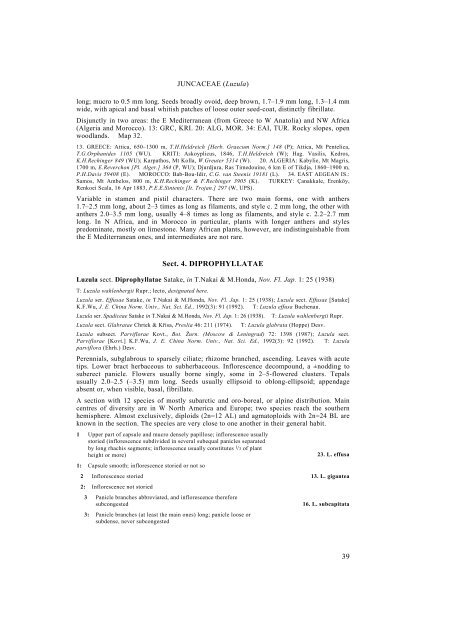Part 6. JUNCACEAE 1: Rostkovia to Luzula - Species Plantarum ...
Part 6. JUNCACEAE 1: Rostkovia to Luzula - Species Plantarum ...
Part 6. JUNCACEAE 1: Rostkovia to Luzula - Species Plantarum ...
You also want an ePaper? Increase the reach of your titles
YUMPU automatically turns print PDFs into web optimized ePapers that Google loves.
<strong>JUNCACEAE</strong> (<strong>Luzula</strong>)<br />
long; mucro <strong>to</strong> 0.5 mm long. Seeds broadly ovoid, deep brown, 1.7–1.9 mm long, 1.3–1.4 mm<br />
wide, with apical and basal whitish patches of loose outer seed-coat, distinctly fibrillate.<br />
Disjunctly in two areas: the E Mediterranean (from Greece <strong>to</strong> W Ana<strong>to</strong>lia) and NW Africa<br />
(Algeria and Morocco). 13: GRC, KRI. 20: ALG, MOR. 34: EAI, TUR. Rocky slopes, open<br />
woodlands. Map 32.<br />
13. GREECE: Attica, 650–1300 m, T.H.Heldreich [Herb. Graecum Norm.] 148 (P); Attica, Mt Pentelica,<br />
T.G.Orphanides 1105 (WU). KRITI: Askoyplicus, 1846, T.H.Heldreich (W); Hag. Vasilis, Kedros,<br />
K.H.Rechinger 849 (WU); Karpathos, Mt Kolla, W.Greuter 5314 (W). 20. ALGERIA: Kabylie, Mt Magris,<br />
1700 m, E.Reverchon [Pl. Alger.] 364 (P, WU); Djurdjura, Ras Timedouine, 6 km E of Tikdja, 1860–1900 m,<br />
P.H.Davis 59408 (E). MOROCCO: Bab-Bou-Idir, C.G. van Steenis 19181 (L). 34. EAST AEGEAN IS.:<br />
Samos, Mt Ambelos, 800 m, K.H.Rechinger & F.Rechinger 3905 (K). TURKEY: Çanakkale, Erenköy,<br />
Renkoei Scala, 16 Apr 1883, P.E.E.Sintenis [It. Trojan.] 297 (W, UPS).<br />
Variable in stamen and pistil characters. There are two main forms, one with anthers<br />
1.7–2.5 mm long, about 2–3 times as long as filaments, and style c. 2 mm long, the other with<br />
anthers 2.0–3.5 mm long, usually 4–8 times as long as filaments, and style c. 2.2–2.7 mm<br />
long. In N Africa, and in Morocco in particular, plants with longer anthers and styles<br />
predominate, mostly on limes<strong>to</strong>ne. Many African plants, however, are indistinguishable from<br />
the E Mediterranean ones, and intermediates are not rare.<br />
Sect. 4. DIPROPHYLLATAE<br />
<strong>Luzula</strong> sect. Diprophyllatae Satake, in T.Nakai & M.Honda, Nov. Fl. Jap. 1: 25 (1938)<br />
T: <strong>Luzula</strong> wahlenbergii Rupr.; lec<strong>to</strong>, designated here.<br />
<strong>Luzula</strong> ser. Effusae Satake, in T.Nakai & M.Honda, Nov. Fl. Jap. 1: 25 (1938); <strong>Luzula</strong> sect. Effusae [Satake]<br />
K.F.Wu, J. E. China Norm. Univ., Nat. Sci. Ed., 1992(3): 91 (1992). T: <strong>Luzula</strong> effusa Buchenau.<br />
<strong>Luzula</strong> ser. Spadiceae Satake in T.Nakai & M.Honda, Nov. Fl. Jap. 1: 26 (1938). T: <strong>Luzula</strong> wahlenbergii Rupr.<br />
<strong>Luzula</strong> sect. Glabratae Chrtek & Křísa, Preslia 46: 211 (1974). T: <strong>Luzula</strong> glabrata (Hoppe) Desv.<br />
<strong>Luzula</strong> subsect. Parviflorae Kovt., Bot. Žurn. (Moscow & Leningrad) 72: 1398 (1987); <strong>Luzula</strong> sect.<br />
Parviflorae [Kovt.] K.F.Wu, J. E. China Norm. Univ., Nat. Sci. Ed., 1992(3): 92 (1992). T: <strong>Luzula</strong><br />
parviflora (Ehrh.) Desv.<br />
Perennials, subglabrous <strong>to</strong> sparsely ciliate; rhizome branched, ascending. Leaves with acute<br />
tips. Lower bract herbaceous <strong>to</strong> subherbaceous. Inflorescence decompound, a ±nodding <strong>to</strong><br />
suberect panicle. Flowers usually borne singly, some in 2–5-flowered clusters. Tepals<br />
usually 2.0–2.5 (–3.5) mm long. Seeds usually ellipsoid <strong>to</strong> oblong-ellipsoid; appendage<br />
absent or, when visible, basal, fibrillate.<br />
A section with 12 species of mostly subarctic and oro-boreal, or alpine distribution. Main<br />
centres of diversity are in W North America and Europe; two species reach the southern<br />
hemisphere. Almost exclusively, diploids (2n=12 AL) and agma<strong>to</strong>ploids with 2n=24 BL are<br />
known in the section. The species are very close <strong>to</strong> one another in their general habit.<br />
1 Upper part of capsule and mucro densely papillose; inflorescence usually<br />
s<strong>to</strong>ried (inflorescence subdivided in several subequal panicles separated<br />
by long rhachis segments; inflorescence usually constitutes 1/3 of plant<br />
height or more)<br />
23. L. effusa<br />
1: Capsule smooth; inflorescence s<strong>to</strong>ried or not so<br />
2 Inflorescence s<strong>to</strong>ried 13. L. gigantea<br />
2: Inflorescence not s<strong>to</strong>ried<br />
3 Panicle branches abbreviated, and inflorescence therefore<br />
subcongested 1<strong>6.</strong> L. subcapitata<br />
3: Panicle branches (at least the main ones) long; panicle loose or<br />
subdense, never subcongested<br />
39












